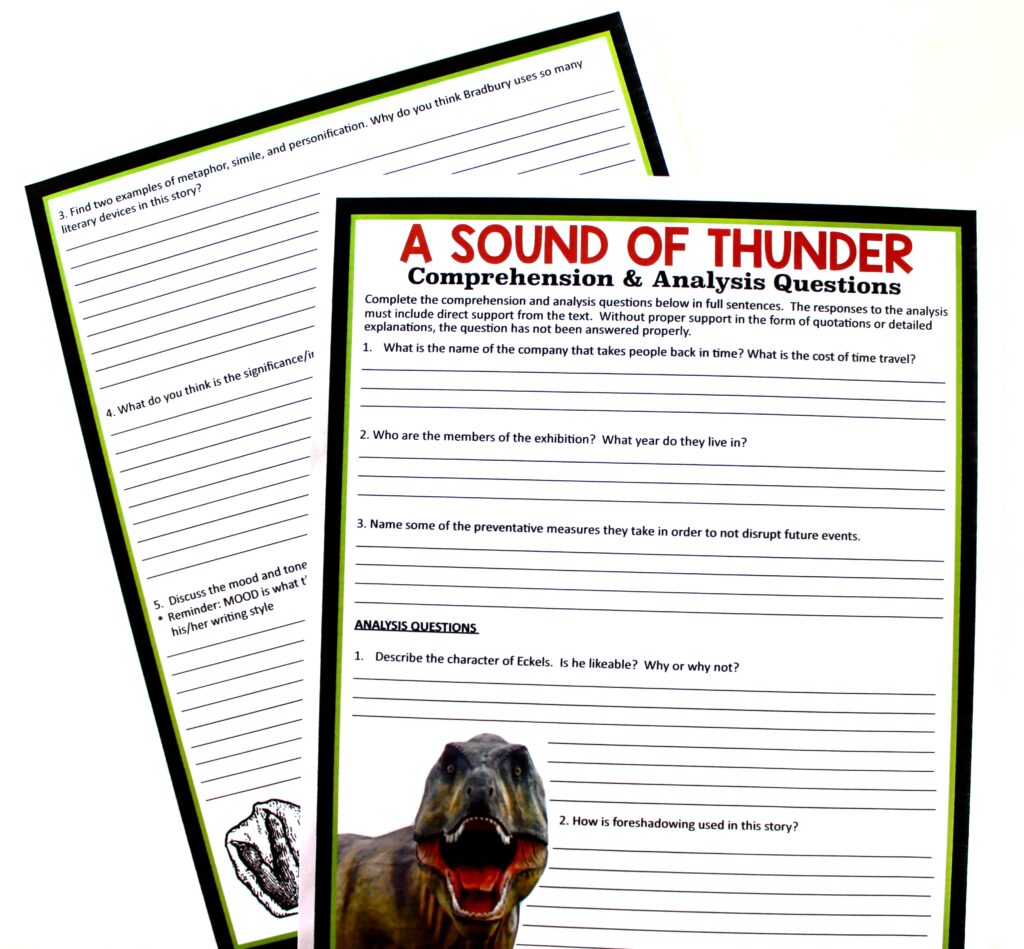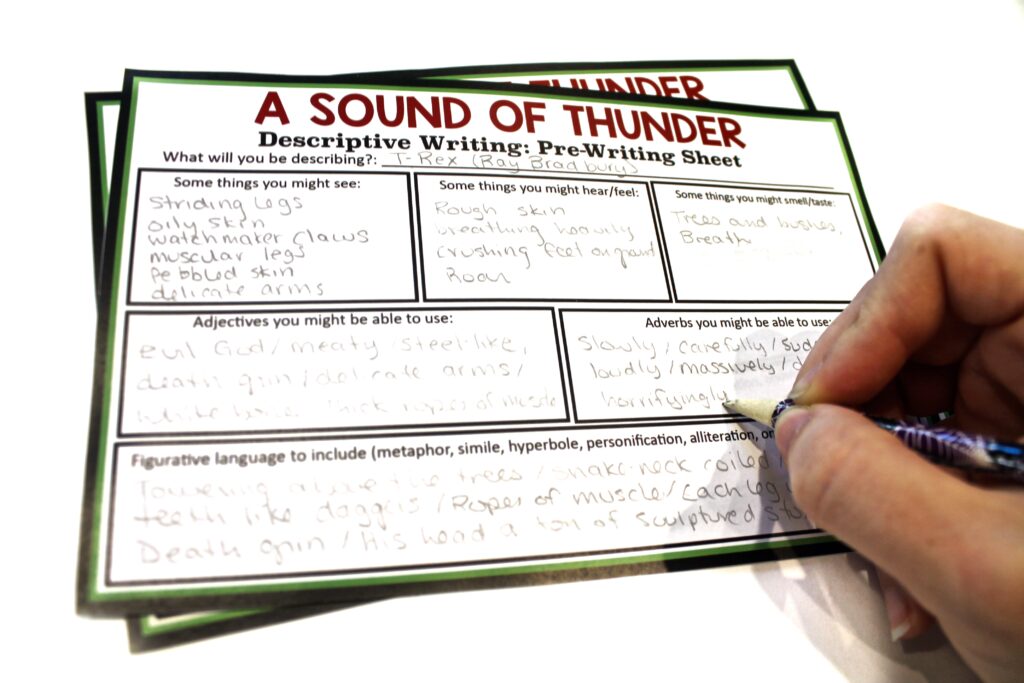PRESTO PLANS
Sent straight to your inbox
CLICK HERE TO ACCESS
Sign up to receive 10 ready-to-use ELA resources your students will love!
10 FREE ELA RESOURCES

Teaching A Sound of Thunder by Ray Bradbury
If you are teaching “A Sound of Thunder” by Ray Bradbury, you might be looking for creative ideas to bring this thought-provoking short story to life for middle or high school students.
In my opinion, “A Sound of Thunder” is a great text to share with students as Halloween approaches! But really, it’s an awesome story to explore at any time of year and can be an excellent way to introduce the science fiction genre to your class.
The story focuses on a hunter named Eckels, who enlists the services of a company called Time Safari, Inc. to travel back in time to hunt extinct animals. Eckels has his heart set on travelling to the Late Cretaceous period to kill a Tyrannosaurus rex. He learns, however, that careless actions in the past can have devastating consequences in the present day.
Are you wondering where to begin when teaching this 1950s sci-fi tale? Here are some of my favourite lesson plan ideas for teaching “A Sound of Thunder.”

Build Background Knowledge
When teaching any short story, I like to begin by helping students build background knowledge. To start, I share some information about Ray Bradbury, giving a brief overview of his career. For example, you might mention that Bradbury was an American fantasy, science fiction, horror and mystery fiction writer who is best known for his novel Fahrenheit 451.
Next, we explore some facts about “A Sound of Thunder,” which was printed in Collier’s magazine in the early 1950s. Up until the mid-1980s, it was the most widely re-published science fiction story!
Pre-Reading Discussion
Because time travel features so prominently in “A Sound of Thunder,” I like to begin teaching this short story with a quick classroom discussion. First, I ask the class to consider historical events they would like to travel back in time and witness. Then, depending on the group, I invite them to share their thoughts with a partner, or the whole class.
From here, I also like to ask some follow-up questions, which usually spark some lively discussions! Some of the questions I invite students to consider are:
- Why would you choose to witness a particular event?
- Are there any people from another time you would like to meet?
- How could time travel be used for good or evil?
I find questions like these help focus reader. It gives them a short preview of what they might expect from the story.
Read the Story
Next, it’s time to read the story! I find that while “The Sound of Thunder” is quite accessible to middle and high school readers, many older students still enjoy the experience of being read to. Consider reading the story out loud to your students for dramatic effect!
As you read, you might pause from time to time to draw attention to certain aspects of the text. If your students are learning how to make annotations, modelling this process can be really helpful. Because “A Sound of Thunder has so much descriptive vocabulary, I like to focus on passages where Ray Bradbury uses figurative language. This is also a useful opportunity to review simile, metaphor, and personification!
I also find it helpful to take a few breaks before key moments in the story and make predictions about what will happen next.
Post-Reading Discussion
Once students have had the opportunity to read the story, I find a post-reading discussion really helps them to unpack their thoughts.
There are a few different ways to structure a post-reading discussion, but I like the think-pair-share model. Here, students are provided with discussion questions and jot down their initial thoughts. Then, they have the opportunity to share their ideas with one or two classmates. Finally, if time permits, each pair or small group can contribute their ideas to a wider classroom discussion. I find these questions often get discussions flowing:
- Would you have chosen to go back in time to hunt? Why or why not?
- Do you think that time-travel could still be a good idea after reading this story?

Reading Questions
After students have had the opportunity to reflect on the text, I like to give them an opportunity to demonstrate their ability to comprehend and analyze “A Sound of Thunder.”
In this part of my lesson plan, I provide students with comprehension and analysis questions and ask them to respond in complete sentences. For the analysis portion of the task, I encourage them to refer back to the story, citing specific evidence and examples to support their ideas.
Before students begin this task, it is sometimes useful to do another quick review of some of the literary terms that apply to “A Sound of Thunder.” Reminding the class about foreshadowing, simile, metaphor, and personification can support them as they complete the comprehension and analysis questions.

EC Comics
One of the things I love most about teaching “A Sound of Thunder” is sharing a creative adaptation of the story created by EC Comics. Students are often surprised to learn that a comic book version of Ray Bradbury’s Story was developed without his permission! Bradbury contacted the publishers complimenting their work. He also politely asked for credit and a reasonable payment fee for the adaptation.
If time permits, students can compare and contrast the comic book version of “A Sound of Thunder” with the original short story. This is an interesting way to explore how stories can be shared in a variety of formats! You could even extend this task by asking students to evaluate the pros and cons of various storytelling methods. This might lead to a fun classroom debate!
Butterfly Effect
Often, I find students are fascinated by Ray Bradbury’s exploration of actions and consequences in this short story. When teaching “A Sound of Thunder,” I like to lean into this curiosity by helping them explore the Butterfly Effect.
In this extension of my lesson, I start by giving a brief overview of the idea of the Butterfly Effect, which is part of a wider scientific theory that describes how tiny variations can affect large and complex systems. For example, it considers the idea that if a butterfly flaps its wings in Asia, there could be a tornado in Texas as a result!
Then, I like to share a brief video explaining this theory, and allow students some time to reflect on their new understandings. Finally, I invite them to consider the ways in which Ray Bradbury uses the concept of time travel in “A Sound of Thunder” to explore this complex concept.
Descriptive Writing Assignment
One of the reasons I enjoy teaching “A Sound of Thunder” so much is Ray Bradbury’s creative and vivid use of descriptive writing. I find that sharing high-quality examples of writing to students often inspires them to express their creativity in new ways!
To begin this final task, I like to draw attention to Bradbury’s descriptive paragraph about the first time Eckels encounters the T-Rex. Here, I highlight the figurative language terms from earlier lessons – metaphor, simile, personification, and hyperbole. We also discuss imagery, and the words Bradbury chose to create a vivid picture of the encounter in the reader’s mind.
Now it’s time for students to test their own creative writing skills! For this final task, I ask them to write a descriptive paragraph that includes imagery, figurative language, and strong word choice. I like to leave this writing assignment quite open-ended, encouraging students to describe any place, experience, or person they wish. For those who have trouble deciding which topic to write about, I display a list of potential suggestions, including:
- A walk in the forest
- A trip to the dentist
- A school bus
- A locker
- A pet
- A food item that has been left in the fridge for too long!

There you go! I hope this has given you some creative ideas for teaching “A Sound of Thunder” in your middle or high school classroom.
If you love scary stories at this (or any!) time of year, you might also want to check out my Scary Short Stories Bundle! It contains a variety of creative, no-prep lessons to teach seven different spooky short stories! Or you can grab the ready-to-use resource for this short story below:

Search the blog for what you are teaching
GIVEAWAYS
sent straight to your inbox!
share this post